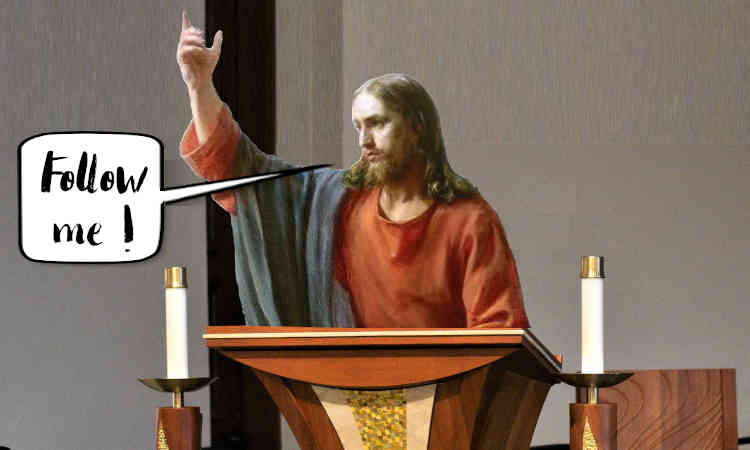Last post I looked at one thing the modern church could learn from Jesus – he treated people as individuals. In the records we have, each person received a different response, tailored to each one’s own circumstances and needs. This is in contrast to how too often the church’s message to the outside world is the same every time.
In this post: two more ways we could learn from Jesus and make the church great again! 🙂 (Well at least make it better!)
2. Memorable teaching
Jesus’ used interactive methods in his public teaching.
- He was renowned as a teller of parables – stories that gave his listeners something to think about rather than telling them what to think. Cryptic sayings served a similar purpose.
- He used figures of speech like metaphors, hyperbole, irony, aphorisms and humour to make his words more colourful and memorable.
- Many of his public teachings were spoken as part of a two way back-and-forth dialogue. This was common practice among rabbis of his day.
- He used actions and current events as opportunities to teach – e.g. the tower that fell, killing people, in Luke 13:4.
- He was able to adapt his teaching to speak simply to Galilean peasants, with examples from daily life, yet use sophisticated rabbinical argument when debating the religious leaders.
All of this meant people flocked to him him speak (though the possibility of seeing a miracle or being healed no doubt helped!).
Like other rabbis, he also used interactive methods when teaching his disciples in private.
- It seems likely that he taught his followers simply structured teachings, using mnemonics, repetition, memorable phrases and other rhetorical devices to aid memory.
- Questions to his followers, e.g. “Who do people say that I am?” (Matthew 16:13-20), tested out their understanding, provoked thought and led to further discussion that revealed further truths.
- He apprenticed his disciples. He taught them about the kingdom of God and showed them how to teach and heal, then sent them out to do the same (Luke 9:1-6).
As a result, his followers were able to remember his teachings and apply them after he had left them.
Active vs passive learning
These are all “active learning” methods, which build on the fact that people learn best when they are active, engaged, interested, curious and motivated. (There are good neurological reasons for this.)
Contrast this with the average church service, where the main teaching is through a monologue sermon. Sure, there may be some visuals, some text on screen, which is at least a start. But look around and you’ll likely see people who aren’t engaged. Unless they are particularly interested in the topic or are taking notes, it probably won’t be active listening.
Some speakers think telling a joke at the start will help, but in fact it generally wastes the time when people are most attentive. The jokes should be later.
There are lots of ways to make this situation better. But the starting point is to be willing to learn from Jesus, and from the learning experts.
3. A bigger gospel
Many churches are zealous for the gospel. And they define the gospel something like this. We are all sinners, we deserve to die as punishment, Jesus the perfect son of God lived the life we couldn’t live and died the death we deserved, rose again victoriously, and all we have to do is accept his offer of forgiveness and we can have assurance of going to heaven at the end of our life.
That’s all true and important, but it’s way short of the gospel Jesus taught.
The word “gospel” means “good news”, and the good news that Jesus preached was about the reign of God on earth. The Jews were living in subjugation to the Roman Empire, and they were looking for a Messiah (= a king) to rid them of that yoke. Jesus said he was that Messiah, but he was beginning a different type of kingdom – a kingdom where God ruled peacefully through Jesus, and his people living the way of Jesus.
Mark sums it up in 1:15. The good news was that God was establishing his rule through Jesus. And this was more than personal salvation and ticket to heaven.
In Luke 4 he explains, using the words of the prophet Isaiah, that he had come to make wrong things right, to “proclaim good news to the poor …. freedom for the prisoners and recovery of sight for the blind, to set the oppressed free, to proclaim the year of the Lord’s favor”.
So surely our zeal for the gospel should extend to the gospel Jesus taught?
Putting faith and actions together
We face a significant challenge. Paul says (Ephesians 2:8-9) that we are saved by grace through faith, which leads many christians to be wary of the “social gospel” that seems to them to suggest our good actions save us.
But Jesus says (Matthew 25:31-46) that our care for the poor and oppressed will determine our destination in the age to come. His brother James says (James 2:14-26) that faith without actions is dead, and that our actions must “complete” our faith so the two go together.
These statements present us with a dilemma. Is it faith or works? Often the way out of a dilemma is to ignore one side of the issue and run hard with the other side. Liberal and evangelical christians tend to do that with opposite sides of the dilemma.
But Jesus’ gospel helps us resolve the dilemma. The good news is more than personal salvation, but the renewing of all creation, starting with personal and social renewal right now. Our acceptance with God will always be a result of his grace and love towards us, but our faith and our actions are both involvd in receiving his forgiveness and participating in the kingdom he is establishing.
Benefits for church and world
Teaching a bigger gospel, Jesus’ gospel, has many advantages.
- If it’s the truth, as I believe it is, then it must be better to know and teach the truth.
- A faith where loving service in the world is an essential part will be more attractive to outsiders than a faith that seems selfish (“I know I’m going to heaven.”) and condemnatory (“You’re a sinner!”). Outsiders will know they are loved and valued, and will more likely want to be part of such a community.
- This bigger gospel inspired the early christians to serve, live lovingly and spread the word, and it can inspire christians much more than a passive sit-in-the-pews-and listen-to-a-sermon-then-go-home kind of faith.
- Those who are reconstructing their faith because of negative reactions to the church may be encouraged to see faith, God and the church in a different light.
Following Jesus?
People, organisations and movements gradually develop habits and habitual ways of thinking. It’s natural. And so the modern Protestant church has developed a culture that often emphasises:
- conformity in doctrine and behaviour,
- a one-size-fits-all approach to people, discipleship and evangelism,
- teaching that is monochromatic, keeps people passive and doesn’t change them much, and
- a gospel that is small, convenient, controllable and undemanding.
Will we learn from Jesus, the pioneer and perfecter of our faith (Hebrews 12:2), take the risk, and start to make the changes?
Could this be one of the ways God is leading us to turn the church around, and turn around the statistics of decline in the western church?





